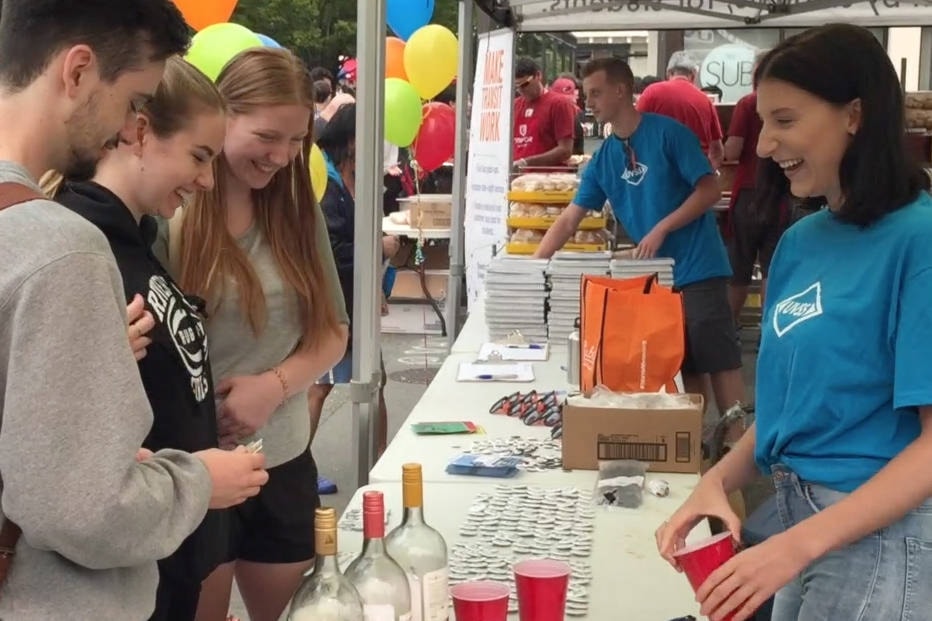Lunch approaches and the outdoor beer garden in the heart of the University of Victoria’s campus begins to fill up. It is Wednesday, a little more than 24 hours after the opening of the fall semester. Smoke from distant wildfires has greyed out the sky, but the mood appears bright, as students go about their business.
Some daydream on a nearby grass patch, others line up for a free hot dog lunch, drawing curious looks from those on the other side of the metal fences that ring off the outdoor beer garden.
Anmol Swaich, director of campaigns and community relations with the University of Victoria Students’ Society, has set up shop between the beer garden and the long queue. She and volunteer Hannah Meffen wear matching blue T-shirts with the UVSS logo as they stand behind a table underneath a large fold-up tent. A green-and-white banner that reads Safe Use in stylized block letters flanks them.
Two young male students in shorts lining up for hot dogs get curious about the three large bottles and red solo party cups that stand out among the brochures on the table. They ask a few questions, then politely decline to play a game that asks them to guess the volume of one ounce of hard liquor, five ounces of wine and 12 ounces of beer by pouring water out of the bottles into a solo cup.
Others however have already taken up Swaich and Meffen and many appear surprised when they learn that they consistently under-estimate their own alcohol consumption.
“The cups are deceivingly wide, so you think you are pouring a lot less than you really,” said Swaich. “We were doing this [when students moved into residence] and we had parents also quite surprised by how much one inch actually is.”
Such simple but nonetheless effective demonstrations point to the central purpose of Safe Use: educate students, so that they can make better choices when it comes to alcohol and drug consumption during the coming school year. To this end, it is offering students a variety of activities that appear as alternatives to events involving alcohol and drugs and a wide range of resources to ensure students do not harm themselves and others while consuming drugs and alcohol.
Not surprisingly, alcohol remains the drug of choice among Canadian university students. According to one estimate published in 2012 by University Affairs, almost 90 per cent of Canadian students consume alcohol, while 32 per cent reported drinking heavily at least once a month. To be fair, students in British Columbia appear to be teetotalers compared to students elsewhere, based on the available, not always comparable data.
While 51 per cent of students in Nova Scotia report to be heavy drinkers, according to the University Affairs story, the Canadian Campus Survey of 2005 reports almost 20 per cent of undergraduates in B.C. report heavy, frequent drinking, consuming five drinks or more on the days that they drink at least once a week.
But this relative form of temperance hardly qualifies as cheerful. While Swaich does not have any hard statistics, alcohol remains a significant problem. “Drinking is a huge one,” she said. Various types of party drugs — cocaine, MDAM (also known as ecstasy) — have also made in-roads on campus, she said. “They are also definitely students, who probably do use opioids [like fentanyl]. Now they are finding fentanyl and stuff in all sorts of drugs, so it doesn’t really matter any more what students are using.”
Opioids have killed about 900 people in British Columbia.
Efforts to deal with fentanyl on campus have been underway for some time. “UVic’s Student Health Services has made Naloxone kits available for students for the past 10 months, ” said Joel Lynn, executive director of student services. “Since April 2017, our nurses have trained and distributed eight kits to students,” Lynn said. “Some of these students have indicated that the Naloxone is not for personal use, but they want to act as responsible hosts by having a kit available as a preventive measure for social occasions. In one instance, a student told us that a group was going to a music festival and asked to be trained to use the kit in the event it was needed.”
Health Services keeps about 30 Naloxone kits on hand and regularly maintains and replenishes the supply, said Lynn. In addition to supplying Naloxone, registered nurses are also available to educate students on how to use Naloxone and show them were to seek additional resources on addiction and substance use if interested, Lynn added.
The university has also launched a pilot project to set up a harm reduction supply station in the student union building to help the student society offer harm reduction supplies and information to interested students.
Overall, UVSS will be offering Naloxone training throughout the next year, twice in September and once a month afterwards, said Swaich. “That way, you will be even more prepared,” she said.
UVic has also made a major intellectual contribution to the fight against fentanyl as university scientists had developed a mobile drug detector that will help first responders.



